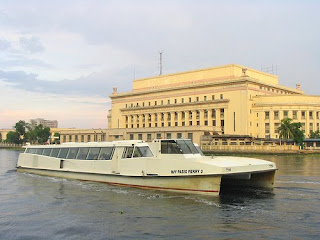
Lanchas (boats) and the river in a pier, the way it was.
Epifanio Delos Santos Avenue, this is probably the most important road in Metro Manila. It is the major link that bridges the gap between the North and the South of the Metro, as well as its suburbs. But the way we were, before the first truck of asphalt was spread out in this famous avenue, we were utilizing this so called "pearl" to link the then imperial capital to its outskirts. Pasig River was the main thoroughfare of the predecessor of today's Metro Manila.
Pasig River connects the Laguna de Bay (Philippine's largest lake) and Manila Bay. Whenever that Laguna de Bay overflows with water already, especially in the wet season, it flashes the excess to Manila Bay via this river. Pasig isn't just a nature's way of making a balance but it also became a very important connection for culture and commerce in the capital.
It was said that even before the Spanish era, the river was already used in daily needs by early Islamic-Chino-Indo kingdoms that flourished on its banks.
By the coming of the Spaniards, the river was mainly used for trade and transportation. Intramuros, the imperial capital, was built in its southern portion. El Filibusterismo, one of Rizal's two famous novels, mentions that the Pasig River had ferries that were used for mass transport. Even the imperial high society people utilized this way of transportation as told in the first chapter of Fili.
Nothing changed when the Americans came. More merchandise were transported in the river from the outskirts going to popular markets.
After the Second Wold War, the start of its decline began to be visible. Illegal settlers became rampant who build their shanties along the river's banks. Constructing buildings along the river won't be as bad as what it is now if proper urban planning was applied.
 Some illegal settlers make the polluted Pasig River not just a giant garbage can/ septic tank in one but also a bath.
Some illegal settlers make the polluted Pasig River not just a giant garbage can/ septic tank in one but also a bath.Even poor sanitation of these houses became a problem since these residences do not have proper waste disposal system and they made the river practically a giant garbage can and septic tank all in one. Domestic wastes are just a part of the problem. Pollutants coming from the manufacturing and agriculture industries also killed the river.
Little by little, the death of the river became apparent. Ferries ceased to travel, fishing became impossible and the foul smell alongside its garbages became notorious.
Administrations come and go tried to make some effort to salvage the river.
Its nice to know that transporting through the river was revived by several companies since the 90's. Today its good to hear that its possible to transport via ferry bus that is fully air conditioned from Pinagbuhatan, Pasig to Intramuros. Its not just a way to escape the metro's land traffic but also for us who appreciate Metro Manila landmarks and want to preserve its old charms.
Having the right arm and strategy, we can turn back time and recover the lost mutya (pearl), the mutya ng Pasig (none other than the Pasig River).
Mutya ng Pasig penned by Dr. Nicanor Abelardo, interpreted by Ms. Sylvia La Torre.




No comments:
Post a Comment